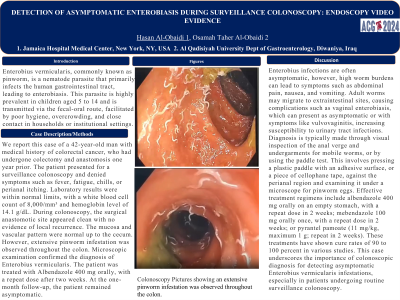Tuesday Poster Session
Category: Endoscopy Video Forum
P3886 - Detection of Asymptomatic Enterobiasis During Surveillance Colonoscopy: Endoscopy Video Evidence
Tuesday, October 29, 2024
10:30 AM - 4:00 PM ET
Location: Exhibit Hall E

Has Audio

Hasan Al-Obaidi, MD
Jamaica Hospital Medical Center
Briarwood, NY
Presenting Author(s)
Hasan Al-Obaidi, MD1, Osamah Taher. Al-Obaidi, 2
1Jamaica Hospital Medical Center, Briarwood, NY; 2Al Qadisiyah University, Diwaniya, Al Qadisiyah, Iraq
Introduction: Enterobius vermicularis, commonly known as pinworm, is a nematode parasite that primarily infects the human gastrointestinal tract, leading to enterobiasis. This parasite is highly prevalent in children aged 5 to 14 and is transmitted via the fecal-oral route, facilitated by poor hygiene, overcrowding, and close contact in households or institutional settings.
Case Description/Methods: We report this case of a 42-year-old man with medical history of colorectal cancer, who had undergone colectomy and anastomosis one year prior. The patient presented for a surveillance colonoscopy and denied symptoms such as fever, fatigue, chills, or perianal itching. Laboratory results were within normal limits, with a white blood cell count of 8,000/mm³ and hemoglobin level of 14.1 g/dL. During colonoscopy, the surgical anastomotic site appeared clean with no evidence of local recurrence. The mucosa and vascular pattern were normal up to the cecum. However, extensive pinworm infestation was observed throughout the colon. Microscopic examination confirmed the diagnosis of Enterobius vermicularis. The patient was treated with Albendazole 400 mg orally, with a repeat dose after two weeks. At the one-month follow-up, the patient remained asymptomatic.
Discussion: Enterobius infections are often asymptomatic, however, high worm burdens can lead to symptoms such as abdominal pain, nausea, and vomiting. Adult worms may migrate to extraintestinal sites, causing complications such as vaginal enterobiasis, which can present as asymptomatic or with symptoms like vulvovaginitis, increasing susceptibility to urinary tract infections. Diagnosis is typically made through visual inspection of the anal verge and undergarments for mobile worms, or by using the paddle test. This involves pressing a plastic paddle with an adhesive surface, or a piece of cellophane tape, against the perianal region and examining it under a microscope for pinworm eggs. Effective treatment regimens include albendazole 400 mg orally on an empty stomach, with a repeat dose in 2 weeks; mebendazole 100 mg orally once, with a repeat dose in 2 weeks; or pyrantel pamoate (11 mg/kg, maximum 1 g; repeat in 2 weeks). These treatments have shown cure rates of 90 to 100 percent in various studies. This case underscores the importance of colonoscopic diagnosis for detecting asymptomatic Enterobius vermicularis infestations, especially in patients undergoing routine surveillance colonoscopy.
Disclosures:
Hasan Al-Obaidi, MD1, Osamah Taher. Al-Obaidi, 2. P3886 - Detection of Asymptomatic Enterobiasis During Surveillance Colonoscopy: Endoscopy Video Evidence, ACG 2024 Annual Scientific Meeting Abstracts. Philadelphia, PA: American College of Gastroenterology.
1Jamaica Hospital Medical Center, Briarwood, NY; 2Al Qadisiyah University, Diwaniya, Al Qadisiyah, Iraq
Introduction: Enterobius vermicularis, commonly known as pinworm, is a nematode parasite that primarily infects the human gastrointestinal tract, leading to enterobiasis. This parasite is highly prevalent in children aged 5 to 14 and is transmitted via the fecal-oral route, facilitated by poor hygiene, overcrowding, and close contact in households or institutional settings.
Case Description/Methods: We report this case of a 42-year-old man with medical history of colorectal cancer, who had undergone colectomy and anastomosis one year prior. The patient presented for a surveillance colonoscopy and denied symptoms such as fever, fatigue, chills, or perianal itching. Laboratory results were within normal limits, with a white blood cell count of 8,000/mm³ and hemoglobin level of 14.1 g/dL. During colonoscopy, the surgical anastomotic site appeared clean with no evidence of local recurrence. The mucosa and vascular pattern were normal up to the cecum. However, extensive pinworm infestation was observed throughout the colon. Microscopic examination confirmed the diagnosis of Enterobius vermicularis. The patient was treated with Albendazole 400 mg orally, with a repeat dose after two weeks. At the one-month follow-up, the patient remained asymptomatic.
Discussion: Enterobius infections are often asymptomatic, however, high worm burdens can lead to symptoms such as abdominal pain, nausea, and vomiting. Adult worms may migrate to extraintestinal sites, causing complications such as vaginal enterobiasis, which can present as asymptomatic or with symptoms like vulvovaginitis, increasing susceptibility to urinary tract infections. Diagnosis is typically made through visual inspection of the anal verge and undergarments for mobile worms, or by using the paddle test. This involves pressing a plastic paddle with an adhesive surface, or a piece of cellophane tape, against the perianal region and examining it under a microscope for pinworm eggs. Effective treatment regimens include albendazole 400 mg orally on an empty stomach, with a repeat dose in 2 weeks; mebendazole 100 mg orally once, with a repeat dose in 2 weeks; or pyrantel pamoate (11 mg/kg, maximum 1 g; repeat in 2 weeks). These treatments have shown cure rates of 90 to 100 percent in various studies. This case underscores the importance of colonoscopic diagnosis for detecting asymptomatic Enterobius vermicularis infestations, especially in patients undergoing routine surveillance colonoscopy.
Disclosures:
Hasan Al-Obaidi indicated no relevant financial relationships.
Osamah Al-Obaidi indicated no relevant financial relationships.
Hasan Al-Obaidi, MD1, Osamah Taher. Al-Obaidi, 2. P3886 - Detection of Asymptomatic Enterobiasis During Surveillance Colonoscopy: Endoscopy Video Evidence, ACG 2024 Annual Scientific Meeting Abstracts. Philadelphia, PA: American College of Gastroenterology.
